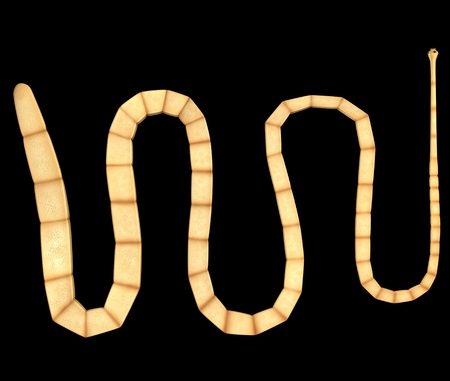
Tapeworms conjure images of 30ft wriggling worms holed up within our intestines and your grandmother telling you to make sure pork is well cooked or you might regret it. These parasites have largely been eradicated from the food chain because of stronger food safety regulations in both supply and processing of meats. They still however, can enter the food chain if good practice slips.
The most problematic tapeworm of history, the beef tapeworm, Taenia saginata can often recur even with good farming and food practice. Back in 2001, 97 cases were reported in England and Wales, there may well have been a smaller but significant number reported in Scotland.
The adult tapeworm usually attaches itself to the intestines of its adult host, a human. The particular species we’ve mentioned resides only in its definitive host, humans ! The head, known as the scolex, literally bites into the intestinal wall, usually the small intestine and stays there, bathed in the digestive, nutrient-rich foods. Growth can be rapid.
Its eggs are passed out in faeces. When they pass onto grazing land, they are eaten by their intermediate host, cattle. These hatch in the gut of the host releasing cysts (Cysticercus bovis) which move via the blood into muscle. Any undercooked meat means cysts can survive and reinfect humans when eaten. Hence, the lifecycle is repeated ever onwards.
It is possible to live with a 20 ft tapeworm living inside you as reported by a gent in China who complained of stomach pains, back in early 2016. The tapeworm was the product of eating raw beef over a number of years which in at least one instance contained a cyst. The tapeworm had probably lived inside the gut for up to 2 years to reach such a size. Infection for want of a better word is often characterised by abdominal pains, vomiting, severe weight loss, anorexia, weakness and malingering. It is certainly not pleasant and very often, a situation rarely diagnosed without some simple forethought.
The most effective analysis is by examining faeces for tapeworm eggs.
The best way to remove a tapeworm is simply to be given a medicine which kills it and then just wait for it to pass through the intestine. Not entirely pleasant but probably highly satisfying and all the symptoms disappearing in the process.
Whilst cooking food thoroughly is the best way to avoid tapeworm infection, it is also important to ensure grazing cattle are kept on clean pasture. That means, making sure pasture is not manured with untreated human waste simply because of keeping the cycle going.
Leave a Reply